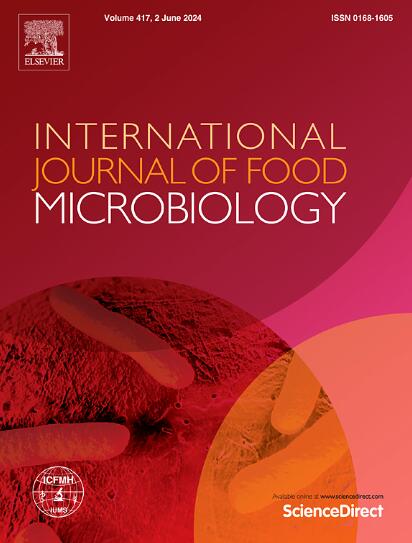Fabrication of Plantaricin FB-2 loaded chitosan/agar coatings: Enhancing antimicrobial activity and prolonging fresh pork shelf life
IF 5
1区 农林科学
Q1 FOOD SCIENCE & TECHNOLOGY
International journal of food microbiology
Pub Date : 2025-06-24
DOI:10.1016/j.ijfoodmicro.2025.111329
引用次数: 0
Abstract
Fresh pork is highly prone to spoilage from oxidation and microbial growth. Utilizing edible coatings made from polysaccharides and bacteriocins is an effective strategy to preserve the quality of fresh pork. In this study, a coating film with antimicrobial properties was developed by grafting chitosan (CS) and agar (AG) together and then incorporating the bacteriocin Plantaricin FB-2. The interaction among these three components was verified using Fourier transform infrared (FTIR) spectroscopy and X-ray diffraction (XRD) analysis. Scanning electron microscopy (SEM) showed that increasing the content of Plantaricin FB-2 in the coating film would change the surface texture of the coating film, making it less smooth. Meanwhile, it would also enhance the hardness and water-holding capacity of the coating film. Additionally, all the coating solutions demonstrated excellent biocompatibility. The inhibition zones for CS/AG/64 and CS/AG/128 against Staphylococcus aureus measured 12.26 mm and 14.56 mm, respectively. The CS/AG matrix also exhibited a slow-release effect on Plantaricin FB-2. The CS/AG/128 coating film effectively preserved the appearance and quality of fresh pork for at least 14 days, as demonstrated by five indicators: color value (L*), juice loss, pH, total volatile basic nitrogen (TVB-N), and total colony count. This antimicrobial-coated film shows significant potential as a packaging material for fresh pork preservation and controlled release. In conclusion, this approach not only extends the shelf life of fresh pork but also offers a promising solution for sustainable food preservation, potentially transforming the landscape of fresh pork packaging.
植物皂苷FB-2壳聚糖/琼脂膜的制备:提高鲜肉的抗菌活性和延长鲜肉的保质期
新鲜猪肉很容易因氧化和微生物生长而变质。利用由多糖和细菌素制成的可食用涂层是保持新鲜猪肉品质的有效策略。本研究将壳聚糖(CS)与琼脂(AG)接枝,再加入细菌素Plantaricin FB-2,制备了具有抗菌性能的涂膜。利用傅里叶红外(FTIR)光谱和x射线衍射(XRD)分析验证了这三种成分之间的相互作用。扫描电镜(SEM)显示,增加涂膜中Plantaricin FB-2的含量会改变涂膜的表面织构,使涂膜的光滑度降低。同时,还能提高涂层的硬度和保水能力。此外,所有涂层溶液均表现出良好的生物相容性。CS/AG/64和CS/AG/128对金黄色葡萄球菌的抑菌带分别为12.26 mm和14.56 mm。CS/AG基质对Plantaricin FB-2也有缓释作用。CS/AG/128包衣膜对鲜肉的外观和品质至少保持了14天以上,这5项指标:色值(L*)、汁损失、pH、总挥发性碱性氮(TVB-N)和总菌落数。这种抗菌剂涂层薄膜作为保鲜猪肉和控制释放的包装材料显示出巨大的潜力。总之,这种方法不仅延长了新鲜猪肉的保质期,而且为可持续食品保存提供了一个有前途的解决方案,有可能改变新鲜猪肉包装的格局。
本文章由计算机程序翻译,如有差异,请以英文原文为准。
求助全文
约1分钟内获得全文
求助全文
来源期刊
CiteScore
10.40
自引率
5.60%
发文量
322
审稿时长
65 days
期刊介绍:
The International Journal of Food Microbiology publishes papers dealing with all aspects of food microbiology. Articles must present information that is novel, has high impact and interest, and is of high scientific quality. They should provide scientific or technological advancement in the specific field of interest of the journal and enhance its strong international reputation. Preliminary or confirmatory results as well as contributions not strictly related to food microbiology will not be considered for publication.

 求助内容:
求助内容: 应助结果提醒方式:
应助结果提醒方式:


